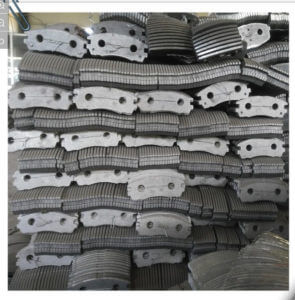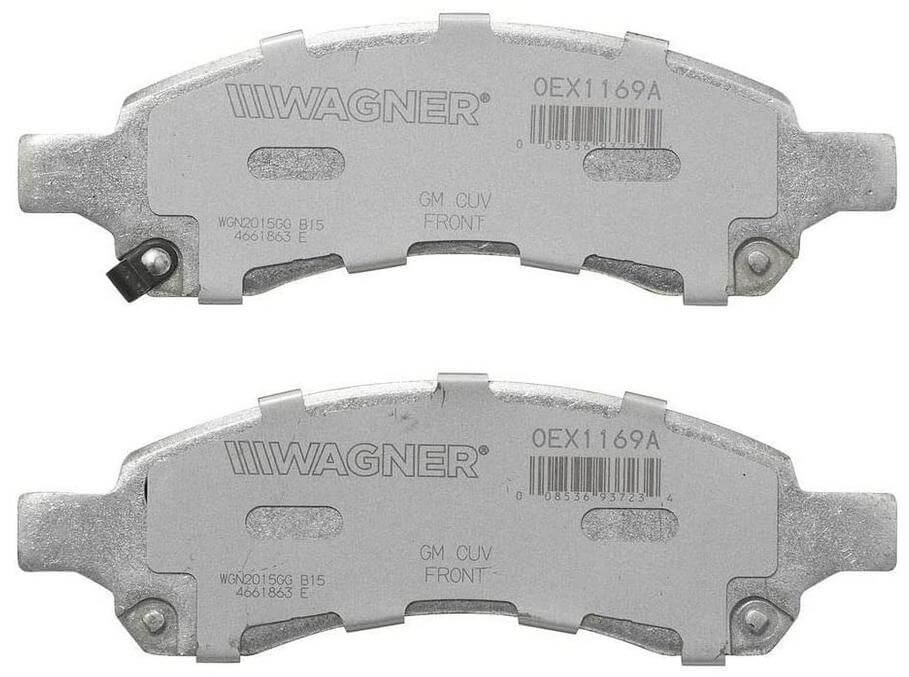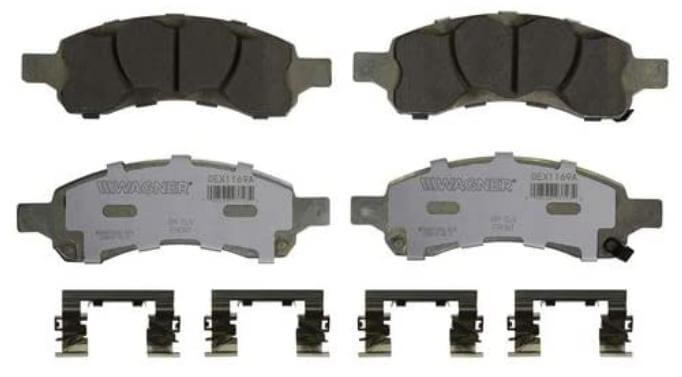Brake pad quality
Brake pad quality levels
Brake pads vary in quality
The brake parts installed on new vehicles at the assembly plant must meet rigid Government safety standards. To get certified for installation on a new vehicle, they must pass a battery of laboratory tests that measure stopping power, fade, fire, and rust resistance. That testing is not only costly but the tests must be performed on the brake parts designed for each model variation. For instance, the brake parts for a 4WD or AWD version are often different than the brake pads for the same year, make and model with just 2WD, due to the difference in vehicle weight. That’s a lot of testing.
To come up with brake parts that’ll pass muster, car makers work closely with their “Tier 1” brake parts suppliers (and trusted sub-contractors) to develop just the right combination of friction material and brake pad backing plate metallurgy, along with the right rotor formulation to pass the tests. The formulas and specifications are a closely guarded trade secret. NO car maker would ever hand out those secret formulas or specifications to an aftermarket supplier. The fact that aftermarket suppliers aren’t privy to the OE formulas is an important fact to keep in mind when you see a brake part that claims to “meet or exceed OE quality.”
Original Equipment Service (OES) brake pads and rotors
If you buy brake parts from the car dealer, you probably won’t get the exact same brake parts that were installed at the assembly plant. Brake parts sold by dealers and auto parts sellers don’t have to meet any Government standards. However, since carmakers want dealer brake parts to be as close as possible to OE performance and be competitively priced at the same time, they supply their dealers with Original Equipment Service (OES) quality parts. Those parts are usually manufactured by authorized “Tier 2” suppliers, using formulas and specifications provided by the carmaker. OES brake parts are often slightly lower quality than OE but perform nearly the same as the OE factory parts. OES parts are technically considered aftermarket parts, but since they’re made in partnership with the carmaker, they’re usually considered a class onto themselves.
Aftermarket brake parts?
All brake parts sold to repair shops and the public through auto parts sellers are referred to as aftermarket brake parts. Aftermarket parts can be made by a Tier 1 or Tier 2 supplier, but they’re sold under a different brand name. Or, they can be made by a company that has no association with a car maker. Federal-Mogul, for example, supplies brake parts to carmakers as a Tier 1 or 2 supplier. But they also sell their brake parts to auto parts sellers under the Wagner brand name. Aftermarket brake parts can be manufactured in North America or imported from offshore suppliers.
Since aftermarket manufacturers can’t get their hands on OE formulas and specifications they have to reverse engineer the OE brake parts. That entails grabbing samples off of brand new vehicles. The samples can’t come from the dealer parts department because those are OES parts.
So brake pad manufacturers reverse engineer a car maker’s pads to determine the raw material content and percentages, the dimensional specifications and features, and the metallurgy used in the backing plate and rotor. However, even if they manage to reverse engineer the formula and metallurgy, they can’t possibly know if their efforts were successful unless they subject their parts to the same laboratory testing the car makers performed. How else could they say with confidence that their product “meets or exceeds OE” quality? Due to the high cost of those tests, only the largest and most reputable brake parts manufacturers can afford to test every brake pad offering.
Smaller aftermarket brake parts manufacturers face the same obstacles but with fewer resources. Some may skip the reverse engineering process altogether and simply come up with a friction formula they feel would work best for a certain year, make, and model. Since smaller companies usually can’t afford to run their own metal stamping or rotor casting operations, they often buy backing plates and rotors from outside vendors. In fact, any company can buy steel backing plates pre-stamped right

Brake pad backing plates from China.
off Alibaba for as little as .20. Some companies sell their products as meeting OE quality without subjecting their products to the same tests as the OE brake parts. Is that legal? Well, kinda.
But aren’t all brake pads safe?
Not always. A brake pad manufacturer can make brake pads that perform adequately in most cases but may fail under severe conditions. Or, a manufacturer can make brake pads that perform well when new but degrade and fail over time due to the use of inferior raw materials. Those manufacturers may be willing to gamble on the odds of being sued for a brake failure that results in injury or death. How likely is it that they’ll be sued? Not very. Here’s a statement from a personal injury law firm commenting on the likelihood of winning a lawsuit against brake parts manufacturers.
“Proving that the manufacturer was liable is often a tricky situation in these kinds of accidents. That’s because you have to showcase the brakes of your vehicle were designed poorly and were liable to suffer from these kinds of failures. It will require a lot of research and showcasing the design of the brakes and why they were prone to fail. It also requires checking into similar cases and displaying when sudden brake failure occurred in the same model as yours.” — Swor & Gotto Personal Injury Lawers @sworgatto.com/understanding-the-risk-of-liability-involved-with-a-brake-failure-lawsuit/
Economy brake pads
Most consumers automatically assume that economy brake pads will perform as well as OE, OES, OEM equivalent or premium brake pads but won’t as long. That’s not necessarily true. If you’ve got an older car or are short on cash, you might be willing to make that trade-off of cost versus pad life. But if the brake pads aren’t even up to OE quality, are you really comparing apples to apples? More importantly, are you willing to risk an accident and injury to another person to save a mere $12 to $25?
Here’s the bottom line: Brake pad manufacturers never really refer to their lowest quality brake pad as an “economy pad.” That’s bad marketing. They leave it up to your imagination to think the pad is the same quality, but with a shorter life. Those brake parts are designed to appeal to “thrifty” buyers; yeah, cheapskates. They’re often made from the lowest quality friction materials and often use thinner backing plates made from low-quality steel. A thinner backing plate can deflect during hard braking and under high heat conditions, causing a loss of braking power and longer stopping distance. A low-quality steel backing plate has less resistance to rust, which causes them to corrode, resulting in friction material “delamination” where the friction material breaks away from the backing plate or breaks into pieces that eventually fall off. Generally speaking, an economy brake pad won’t brake as well under demanding conditions and won’t last as long as a higher quality brake pad.
OEM quality brake pads
OEM “equivalent” brake pads try to duplicate what came on the car. But as I said earlier, no carmaker is ever going to disclose their proprietary formulas to an aftermarket company. So you have to trust the brand to feel confident that you’re getting an OEM equivalent brake pads.
OEM equivalent pads will have better backing plates and higher quality friction material than economy brake pads or store brand parts. They’ll also include the necessary shims and hardware (anti-rattle clips).
Premium quality brake pads
Premium quality brake pads are simply built with top-of-the-line materials. The backing plates in the best premium brands will be made from top-grade galvanized steel to reduce rust (economy and OEM backing plates are lower quality steel and often painted to reduce rust). They’ll also have the same (or better) factory chamfers and grooves as OEM.
Wagner OEX brake pads are an example of premium brake pads
These Wagner OEX brake pads are built on a galvanized steel backing plate, so they won’t rust like a less expensive brake pad. The pads include premium quality noise reduction shims that are already attached to the backing plate, as well as premium hardware.

Notice the galvanized steel backing plates and the premium quality noise reduction shims

Premium brake pads come with shims and hardware
© 2018 Rick Muscoplat
Posted on by Rick Muscoplat
